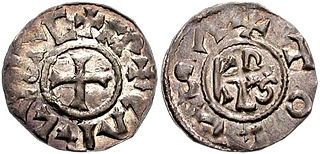
The as, occasionally assarius, was a bronze, and later copper, coin used during the Roman Republic and Roman Empire.

Roman currency for most of Roman history consisted of gold, silver, bronze, orichalcum and copper coinage. From its introduction during the Republic, in the third century BC, through Imperial times, Roman currency saw many changes in form, denomination, and composition. A feature was the inflationary debasement and replacement of coins over the centuries. Notable examples of this followed the reforms of Diocletian. This trend continued with Byzantine currency.
Byzantine currency, money used in the Eastern Roman Empire after the fall of the West, consisted of mainly two types of coins: gold solidi and hyperpyra and a variety of clearly valued bronze coins. By the 15th century, the currency was issued only in debased silver stavrata and minor copper coins with no gold issue.

The solidus or nomisma was a highly pure gold coin issued in the Later Roman Empire and Byzantine Empire. The early 4th century saw the solidus introduced in mintage as a successor to the aureus, which was permanently replaced thereafter by the new coin, whose weight of about 4.5 grams remained relatively constant for seven centuries.

The aureus was a gold coin of ancient Rome originally valued at 25 pure silver denarii. The aureus was regularly issued from the 1st century BC to the beginning of the 4th century AD, when it was replaced by the solidus. The aureus was about the same size as the denarius, but heavier.
Roman Republican currency is the coinage struck by the various magistrates of the Roman Republic, to be used as legal tender. In modern times, the abbreviation RRC, "Roman Republican Coinage" originally the name of a reference work on the topic by Michael H. Crawford, has come to be used as an identifying tag for coins assigned a number in that work, such as RRC 367.

The follis was a type of coin in the Roman and Byzantine traditions.

In the Middle Ages, the term bezant was used in Western Europe to describe several gold coins of the east, all derived ultimately from the Roman solidus. The word itself comes from the Greek Byzantion, the ancient name of Constantinople, the capital of the Byzantine Empire.
From c. 1124 until 1709 the coinage of Scotland was unique, and minted locally. A wide variety of coins, such as the plack, bodle, bawbee, dollar and ryal were produced over that time. For trading purposes coins of Northumbria and various other places had been used before that time; and since 1709 those of the Kingdom of Great Britain, and then of the UK.

Silver coins are one of the oldest mass-produced form of coinage. Silver has been used as a coinage metal since the times of the Greeks; their silver drachmas were popular trade coins. The ancient Persians used silver coins between 612–330 BC. Before 1797, British pennies were made of silver.
The Papal Mint is the pope's institute for the production of hard cash. Papal Mint also refers to the buildings in Avignon, Rome, and elsewhere that used to house the mint.
The Venetian grosso is a silver coin first introduced in Venice in 1193 under doge Enrico Dandolo. It originally weighed 2.18 grams, was composed of 98.5% pure silver, and was valued at 26 denarii. Its name is from the same root as groschen and the English groat, all deriving ultimately from the denaro grosso.

The gold dinar is an Islamic medieval gold coin first issued in AH 77 (696–697 CE) by Caliph Abd al-Malik ibn Marwan. The weight of the dinar is 1 mithqal.

Nummus is a Latin word for various coins that was borrowed from Doric Greek noummos. Originally referring to a specific style of coin used in Greek-speaking Southern Italy, the term nummus came to be used by the Late Republic for all coins generally and particularly as a synonym for the sestertius, then the standard unit of Roman accounting, and then in Late Antiquity as the formal name of the follis. It was used in this general sense in Early Modern English but is most commonly employed by modern numismatists as a catchall term for various low-value copper coins issued by the Roman and Byzantine empires during Late Antiquity.

Billon is an alloy of a precious metal with a majority base metal content. It is used chiefly for making coins, medals, and token coins.

Italy has a long history of different coinage types, which spans thousands of years. Italy has been influential at a coinage point of view: the medieval Florentine florin, one of the most used coinage types in European history and one of the most important coins in Western history, was struck in Florence in the 13th century, while the Venetian sequin, minted from 1284 to 1797, was the most prestigious gold coin in circulation in the commercial centers of the Mediterranean Sea.

The miliaresion, is a name used for two types of Byzantine silver coins. In its most usual sense, it refers to the themed flat silver coin struck between the 8th and 11th Century.
The stavraton or stauraton was a type of silver coin used during the last century of the Byzantine Empire.
The tetarteron was a Byzantine term applied to two different coins, one gold circulating from the 960s to 1092 in parallel to the histamenon, and one copper used from 1092 to the second half of the 13th century.

The Carolingian monetary system, also called the Carolingian coinage system or just the Carolingian system, was a currency structure introduced by Charlemagne in the late 8th century as part of a major reform, the effects of which subsequently dominated much of Europe, including Britain, for centuries. It is characterised by having three denominations with values in the ratio 1:20:240, the units of which went under different names in the different languages, but which corresponded to the Latin terms libra (pound), solidus (shilling) and denarius (penny), respectively.













